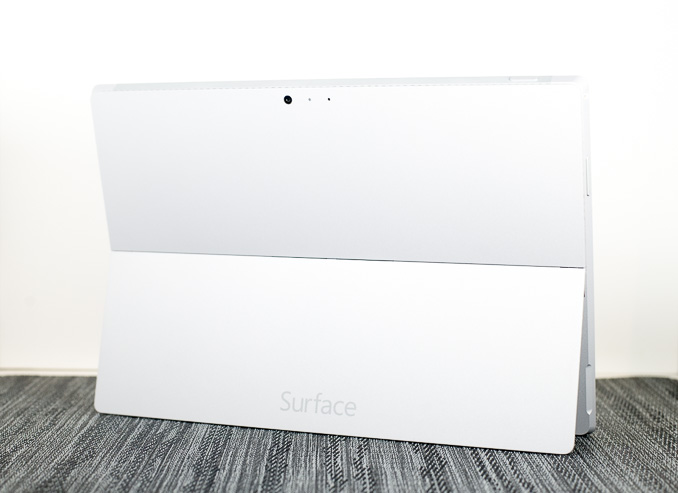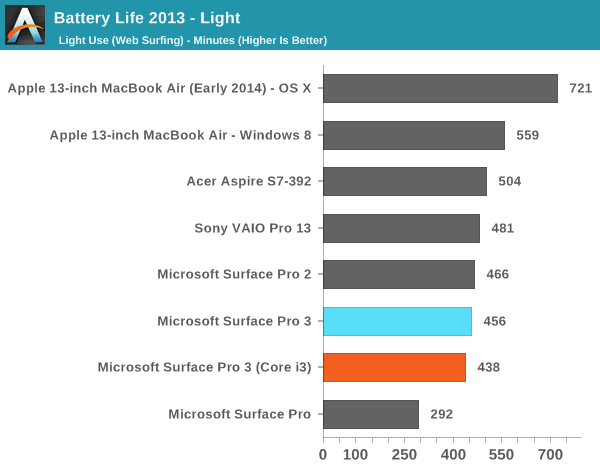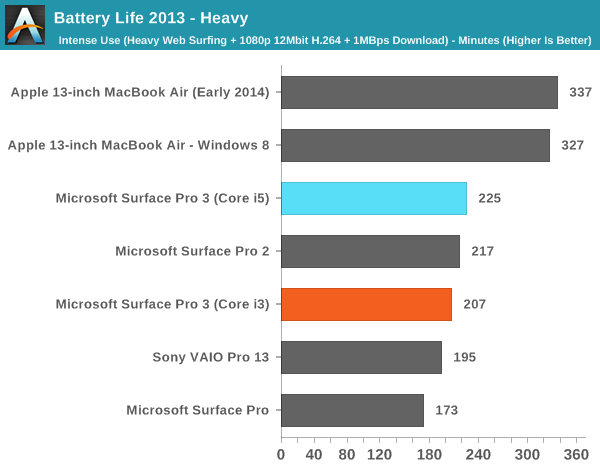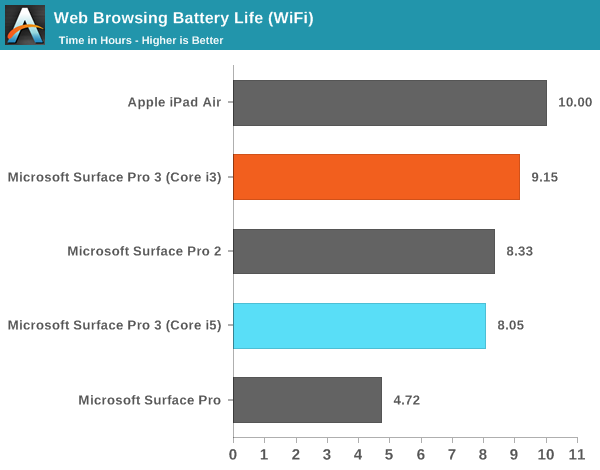Microsoft's Surface Pro 3: Core i3 vs. Core i5 Battery Life
by Anand Lal Shimpi on August 5, 2014 11:20 AM EST- Posted in
- Tablets
- Microsoft
- Mobile
- Surface Pro 3

A couple of weeks ago I offered a brief performance preview of the $799 entry level Surface Pro 3 with an Intel Core i3-4020Y. The performance hit in going down to the $799 model is significant but compared to an upgraded ARM tablet you do get substantially more functionality/performance. The big unknown at the time was battery life. Going down to a Y-series part comes with a reduction in TDP (15W down to 11.5W), which could have power implications.
I spent the past week running and re-running battery life tests on the Core i3 model of the Surface Pro 3. For the most part, battery life hasn't changed. As you'll see from our laptop results, the Core i3 Surface Pro 3's battery life shows a slight regression compared to our Core i5 results but not significantly so:


Although our laptop tests didn't show any gains, our tablet workload showed a substantial increase in battery life for the Core i3 version vs. the Core i5 Surface Pro 3:

An 11% increase in battery life is likely due to the lower power binned Y-series Haswell ULx part. It's interesting to me that the gains are exclusively in our lightest workload and don't appear to be present under any of the more active workloads. The decrease in TDP would imply a reduction in peak active power consumption but perhaps that's more a function of the reduced clocks. What we see at lighter/more idle workloads is a reduction in leakage thanks to the Y-series part.
I still feel like the best overall balance of battery life, storage, performance and price is going to be a Surface Pro 3 equipped with a Core i5. I think where the $799 Core i3 makes sense is if you're budget limited and left with the choice between a 64GB ARM based tablet or the entry level Surface Pro 3. The problem is typically users who stretch their budget to get a 64GB ARM based tablet want the storage space, which is something you sacrifice when you move to a 64GB Windows 8.1 device (roughly 21GB free on a new install). I don't see the $799 Surface Pro 3 necessarily catering to the same market as a high end ARM device, but I think the entry level SP3 does embody Microsoft's mission better than any of the more expensive configurations. There's very little cross shopping between a $499 ARM based tablet and a $1200+ Surface Pro 3, but the entry level SP3 can serve as an in-between device if you want some of both worlds.










85 Comments
View All Comments
hughlle - Tuesday, August 5, 2014 - link
One of the few speculated reasons to pick up an i3, alas it doesn't seem to pan out. Still on the road for an i5 then.basroil - Saturday, August 9, 2014 - link
Nobody every actually believed the i3 would last longer, since even in "heavy" use presented above the i5 is in idle for 5-8ms out of every 15ms frame. If the i3 draws half as much power in max but spends twice as much time there, battery life won't change much. Not to mention the display draws the most power during idle, so the CPU specs are watered down a bit there.StevoLincolnite - Saturday, August 9, 2014 - link
Agreed.It's the "Hurry up and finish" mantra, the sooner the processing can be done and the processor return to a low-power idle state the better it can be for battery life.
basroil - Monday, August 11, 2014 - link
Not just CPU, SSD and other things attached to the mobo will also tend to idle more... as long as you don't use garbage programs like chrome!Walkop - Tuesday, September 9, 2014 - link
Chrome fixed the CPU tick issues (which have been present since v1), causing major battery life problems in the latest Canary build. We're talking 25% less drain, based on a prediction by MS a few years back. Since idle power use has dropped by a very considerable amount in the past couple years on Intel platforms, I wouldn't be surprised if that number is now closer to 35%-40%.It's still considerably slower than I.E. or Firefox, but the featureset keeps a lot of users. Including myself, lol.
Wiidesire - Tuesday, August 5, 2014 - link
Thanks Lal Shimpi for the test, however undervolting was not tested, so the test is useless for me. For unexperienced users however, who don't want to undervolt, this is a good test ;)Devo2007 - Tuesday, August 5, 2014 - link
Does the Surface 3 Pro even allow you to undervolt the CPU? This isn't an Android-powered ARM-based tablet where you can simply root and install SetCPU to accomplish this.Wiidesire - Tuesday, August 5, 2014 - link
Yes, you can use Intel XTU for undervolting with the SP3 :)ewpelleg - Tuesday, August 5, 2014 - link
Your right. This isn't an android device. You don't need to/can't root it to modify it. It is a standard PC.B3an - Tuesday, August 5, 2014 - link
Yes it's a PC, so it's far easier to undervolt and do these kinda things on than anything Android based. Derp.